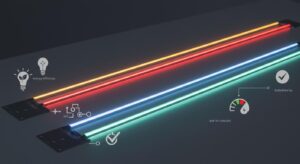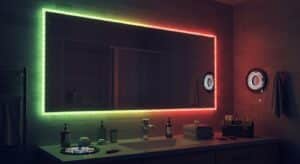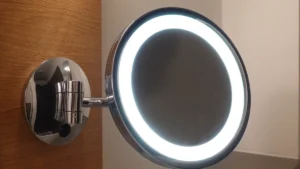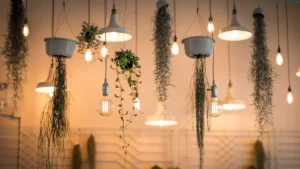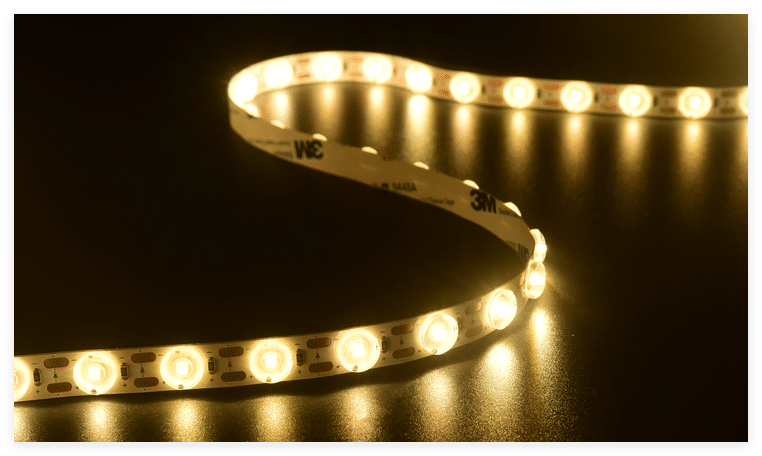
Selecting the appropriate LED light strip power supply is crucial. It ensures optimal performance and prevents damage. Using an unsuitable power source can lead to overheating or subpar functionality. To stay safe, it’s essential to match the voltage and current ratings correctly. Proper installation is equally vital, as faulty connections can compromise your setup and pose risks. This guide provides an overview of these fundamentals and assists the LED light strip power supply buyer in choosing the ideal option for their LED strips.
Key Takeaways
Pick the right power supply to stop overheating and harm. The right supply keeps your LED strips safe and working well.
Match your LED strip’s voltage with the power supply. Correct voltage stops flickering and helps your lights last longer.
Work out the total power by checking wattage per metre and strip length. Add 20% more power for extra safety.
Choose a power supply that uses no more than 80% of its capacity. This keeps it cool, works better, and avoids breaking.
Follow the correct steps and safety rules when installing. Make sure connections are tight and use approved products to stay safe from electrical dangers.
Why the Right Power Supply Matters for LED Strip Lights
Stopping Damage and Overheating
The right power supply keeps your LED strips safe. A wrong one can overheat, causing failures or dangers. Too much heat lowers efficiency and creates problems. Power supplies with overload protection stop these issues. Industrial-grade drivers often have safety features for extra protection.
Efficient power supplies help reduce heat by saving energy. This makes your LED setup more reliable. Good airflow around the power supply is also important. Without it, heat builds up and risks damage.
Improving Lifespan and Performance
A proper power supply helps LED strips work well. Stable voltage stops flickering, which saves energy and looks better. Overloading the supply can wear out LEDs faster, costing more to replace.
A good power supply gives steady power, making LEDs last longer. This keeps brightness and colours consistent over time. Correct installation and good airflow also help your setup last longer.
Staying Safe from Electrical Risks
Wrong power supplies can cause electrical dangers. Overheating and overloading might lead to fires. Power supplies with built-in safety features lower these risks.
Steady voltage is very important. It stops sudden surges that could harm your LED strips or other parts. Picking a high-quality power supply makes your setup safer and more dependable.
How to Find the Voltage of LED Strip Lights
Common Voltage Levels (12V, 24V)
LED strips usually run on 12V or 24V power. These are common, so finding matching power supplies is simple. The voltage depends on the strip’s design and parts. For example, addressable LED strips come in 5V, 12V, or 24V options.
Think about the strip’s length when picking the voltage. Longer strips might need higher voltage to keep brightness even. The table below shows common voltage levels and their limits:
Voltage Type | Minimum Voltage Needed | Power Use Increase |
|---|---|---|
12V LED Strip | 7.5V | 1.0 watts per foot every 0.75V rise |
24V LED Strip | 15.5V | 1.5 watts per foot every 0.75V rise |
Reading Manufacturer Details
To find the right voltage, check the manufacturer’s guide. This info is often on the box or in the manual. Make sure the power supply voltage matches the LED strip’s needs.
For addressable LED strips, confirm if they need 5V, 12V, or 24V. Longer strips often work better with 24V to avoid dimming or uneven light.
Matching Voltage with Power Supply
The LED strip voltage must match the power supply. If the supply voltage is too low, the lights may dim or not work. Too high, and it could harm the LEDs.
There are two main power supply types: constant voltage and constant current. Most LED strips need constant voltage supplies. To find the right power, multiply the strip’s wattage per metre by its length. Add 20% extra for safety. For example, a 5-metre strip using 7W/m needs at least a 35W power supply.
Matching the power supply to the LED strip voltage ensures safety and efficiency. This step helps avoid risks and makes your LED strips last longer.
Calculating Power Needs for LED Strip Lights
Knowing the power needs of your LED strips is important. It helps you pick a safe and efficient power supply. By working out the wattage and amperage, you can avoid damage or poor performance.
What Are Wattage and Amperage?
Wattage shows how much power is used overall. Amperage measures the flow of electricity in the circuit.
To find the amperage, use this formula:
P = V x A, where P is wattage, V is voltage, and A is amperage.
For example, if your LED strip uses 24 Watts and runs at 12 Volts:
24 = 12 x A, so A = 2.0 Amps.
This means your power supply must give at least 2.0 Amps. A supply rated at 36 Watts or 3 Amps is better. It gives extra safety.
Figuring Out Total Power Needs
To find total power needs, check the strip length, LEDs per metre, and power use per LED. Here’s an example:
Description | Value |
|---|---|
Length of strip | 1 metre |
Number of LEDs per metre | 60 |
Current draw per LED | 20 mA |
Total current draw | 1,200 mA |
Total current in amps | 1.2 amps |
Power use per LED | 0.24 watts |
Operating voltage | 12V |
Total power calculation | 1.2 amps at 12V |
This method helps you work out the exact power needs. It ensures your power supply fits your LED strip project.
Using the 80% Rule for Power Supply
Choose a power supply that works at no more than 80% capacity. This keeps it cool and efficient.
For example, if your LED strip needs 24 Watts, pick a supply with at least 30 Watts. This gives a safety buffer.
To find the right supply size, multiply the total power by 1.25. For example:
If your LED strip needs 40 Watts, the supply should be 40 x 1.25 = 50 Watts.
This rule makes sure your LED strip setup is safe and reliable. It also lowers the chance of power supply problems.
Picking the Right Power Supply for LED Strips
Choosing the correct power supply is key for LED strips. It ensures they work well and last longer. By learning about power supply types, matching voltage and current, and checking extra features, you can set up a safe and efficient system.
Types of Power Supplies (Standard, Dimmable, Waterproof)
LED strip power supplies come in different types for various uses. Knowing these helps you pick the best one.
Type of Power Supply | Description | Benefits | Uses |
|---|---|---|---|
Constant Voltage | Gives steady voltage, perfect for fixed LED loads. | Easy to use, common, works with parallel setups. | Indoor LED strips, cabinet lighting. |
Dimmable | Lets you adjust brightness with dimmers. | Adds flexibility, creates mood lighting. | Home and business lighting. |
Waterproof | Made for outdoor use, resists water and dust. | Strong, protects from weather. | Garden lights, outdoor signs. |
Constant voltage supplies are the most popular for LED strips. They are simple to install and great for indoor use. Dimmable supplies let you control light levels, ideal for cosy settings. Waterproof supplies are tough and perfect for outdoor projects.
Matching Voltage and Current
Matching voltage and current is vital for LED strips to work well. Wrong matches can cause damage or shorten their life.
Make sure the power supply voltage matches the LED strip voltage.
Check the power supply current meets or exceeds the LED strip’s needs.
Look at the datasheets for both to confirm they match.
For instance, if your LED strip needs 12V and 2.5 Amps, pick a supply rated at 12V and 3 Amps. This keeps the system safe and avoids overloading.
Extra Features to Think About
When choosing a power supply, consider features that improve your setup. These make it safer, easier, and more effective.
Feature | Description |
|---|---|
Voltage and Wattage Match | Ensure voltage matches and wattage stays below 80% of the supply’s limit. |
Maximum Strip Length | Follow the maximum length to avoid dimming or damage. |
Surge Protection | Use surge protectors to keep voltage steady and prevent harm. |
Dimming Options | Add dimmers to control brightness and extend LED lifespan. |
Installation Needs | Plan for strip length, breaks, power, flexibility, and extra parts like connectors. |
Think about how long your LED strips will be and if waterproofing is needed. Decide if you want dimming options and check for extra parts like wires or connectors. These steps make your setup strong and reliable.
How to Install LED Strip Lights Safely
Installing LED strip lights the right way is important. It helps them work well and keeps everything safe. Follow these steps to get your materials ready, connect wires, and test your setup.
Getting Materials Ready (Strips, Connectors, Wires)
First, collect all the items you need for the job. You’ll need LED strips, a matching power supply, connectors, wire cutters, and a multimeter. If soldering is needed, have soldering tools ready. Measure the area where you’ll install the strips. Only cut the strips at the marked lines.
Safety is very important. Use LED strips with fireproof coatings. Keep them away from things that can catch fire. Make sure there’s good airflow to stop overheating. Pick products with safety marks like UL or CE for quality. The table below shows key safety tips:
Safety Rule | What to Do |
|---|---|
Stop Fire Risks | Use fireproof LED strips and avoid flammable spots. |
Prevent Overheating | Allow airflow and check for damage often. |
Certified Products | Choose items with UL or CE safety marks. |
Professional Help | Hire experts for electrical work to avoid problems. |
Follow Instructions | Read and follow the manufacturer’s guide for proper setup. |
Simple Wiring Steps
Pick the Right Power Supply: Get a power supply that matches your LED strip’s voltage and current. For dimmable lights, use a dimmable power supply.
Prepare the Space: Measure the area and cut the LED strips to fit. Only cut at marked points.
Connect the Power Supply: Attach the power supply to the LED strip. Make sure the positive and negative wires are connected correctly. Use connectors or soldering for strong connections.
Add Controllers for Big Setups: For many strips, use a PWM amplifier. This keeps brightness even across all strips.
Stick the Strips in Place: Use adhesive backing or clips to secure the LED strips to the surface.
Testing and Fixing Problems
Once the wiring is done, test your setup before finishing. Turn on the LED strips and check if the brightness and colours look right. Use a multimeter to check voltage and current. If the lights are dim or uneven, check the power supply and connections. Make sure the power supply matches the LED strip’s needs and that all connections are tight.
For ceiling setups, make sure the strips are stuck firmly to avoid sagging. Fix any problems quickly to prevent damage later. Testing and fixing issues are key steps to installing LED strip lights properly.
Choosing the right power supply helps LED strips work well. First, figure out the strip’s wattage per foot and its length. Then, check the voltage it needs. Pick a power supply with 20% more wattage than required. For instance, if your strip uses 40 watts, get a 50-watt supply.
Installing safely is just as important. Check all connections twice and ensure parts match. Following these steps will make your LED setup strong and long-lasting. If unsure, ask an expert for help.
FAQ
What happens if I use the wrong power supply for my LED strips?
Using the wrong power supply can harm your LED strips. Too much voltage can burn them out. Too little power causes flickering or dim lights. Always match the voltage and wattage to your LED strip’s needs.
How do I calculate the total wattage for my LED strip project?
Find the wattage per metre of your LED strip. Multiply it by the strip’s length. Add 20% extra for safety. For example, a 5-metre strip using 7W/m needs at least 42W (35W + 20%).
Can I connect multiple LED strips to one power supply?
Yes, you can connect more than one strip. Make sure the power supply can handle the total wattage. Use a splitter or amplifier to share power evenly. Check the current draw stays within the supply’s limit.
Why do my LED strips flicker or dim?
Flickering or dimming happens if the power supply is too weak. Loose connections can also cause this. Check the supply matches the voltage and wattage of your strips. Tighten all connections and test again.
Are waterproof power supplies necessary for outdoor LED strips?
Yes, waterproof power supplies are needed for outdoor use. They protect against water and dust. This keeps your setup safe and working well. Look for IP65 or higher ratings for outdoor projects.
See Also
Effective Methods for Installing RGB LED Strip Lights
Ultimate Guide for Using Outdoor LED Light Strips
Best Practices for Installing LED Strip Lights in 2025
